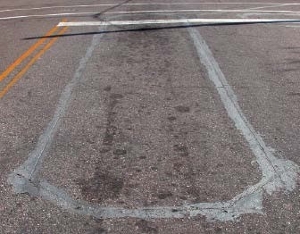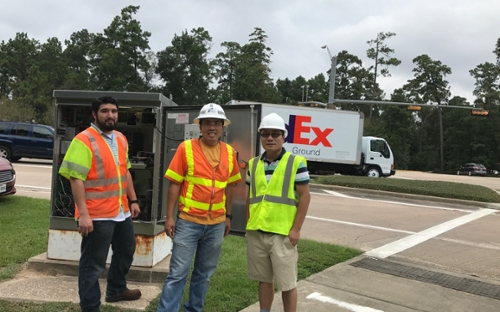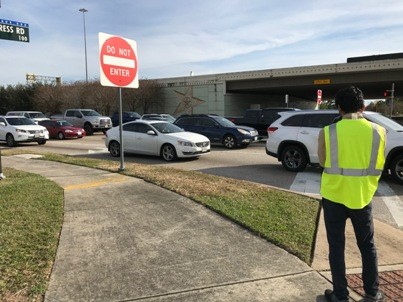Implementation of Proactive Traffic Signal Control System at Multiple Intersections at the Greater Houston Area
This project aims to implement the proactive signal control system proposed in Project 0-6920 to 30 intersections, located in 5 arterial corridors in the Houston Metropolitan Area.
Project PI
Dr. Xing Wu, Associate Professor, Department of Civil and Environmental Engineering
Full Description
This project has 3 major tasks (excluding the project preparation and final report writing), as follows.
Task 1: Data Collection
The data required in this project include (1) testbed geometric information, (2) signal plans, and (3) road traffic information.
The road geometric information, including road length and width, directions, number of lanes, etc., were obtained from field measurements, google maps, and the TxDOT Houston Office.
In addition, current traffic signal phasing and timing plans of all 30 intersections were collected by the Performing Agency.
The LU research team also used loop detector data for network simulations via VISSIM. Additional data resources, such as loop detectors, and roadside cameras were also be used to collect necessary information, including vehicle arrival time, location, speed at intersections.
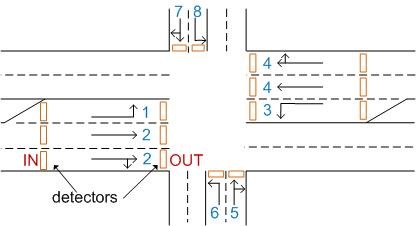
Distribution of Loop Detectors at an Intersection
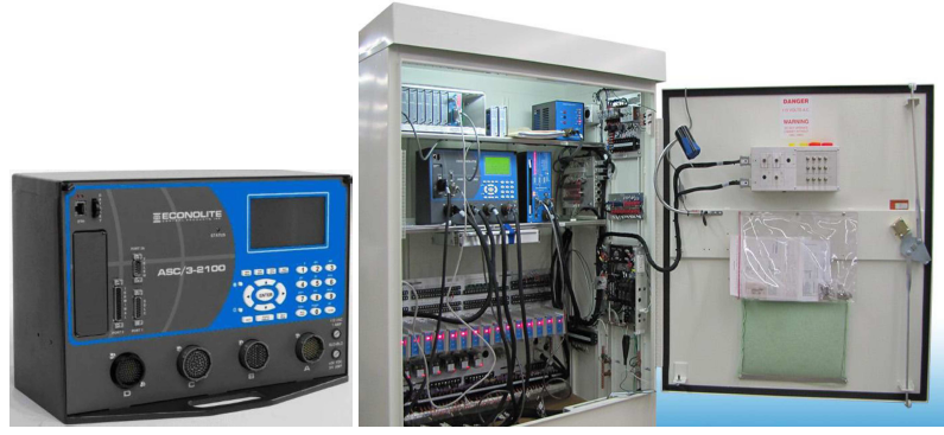
Controller and Roadside Control Box
Task 2: Testbed Modeling and Simulation
Subtask 2.1 –Modeling of Testbeds
The LU research team utilized the testbed geometric information collected in Task 1 to construct the network modeling files of all testbeds. The files contain all information of the testbeds, including road length, lane numbers, road capacities, speed limits, jam densities, and signal phasing and timing plans. In addition, the road traffic information, such as link volumes and speed, will be applied to estimate origin-destination (OD) matrices for the testbeds.
Subtask 2.2 – Simulation Verification and Evaluation
The LU research team conducted a microscopic traffic simulation (via VISSIM) to describe vehicular dynamics and the performance of the intersections at the testbeds, covering both peak and off-peak hours on weekdays and weekends. The simulations shall reproduce the observed traffic conditions from loop detectors, including link volumes, average speed, occupancies, etc., in order to verify the accuracy of the simulation.
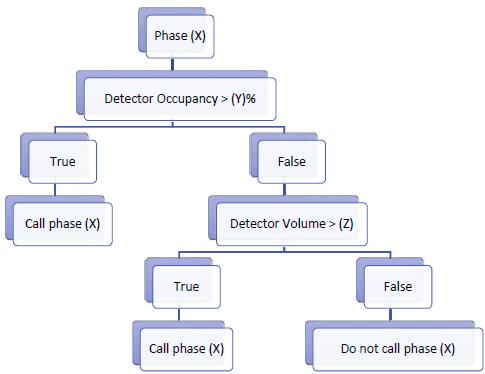
General Control Logic Applied to Intersections
Task 3: Field Implementation
This is the major task of this project. Based on the locations of intersections, this task is divided into 3 phases (subtasks).
Subtask 3.1 – Phase I: FM 528
In the first phase, the LU research team planned to implement the proactive signal control system to one small test bed, FM 528. The testbed has only three intersections, which are all installed with EPAC controllers to operate the signals. The traffic flow at this corridor is not heavy. The implementation at this corridor will be used as the reference for the following implementation tests.
Subtask 3.2 – Phase II: FM 242 and FM 1464
This is the major subtask which aims to implement the proposed proactive signal control system to two long arterial corridors: SH 242 (8 intersections) and FM 1464 (11 intersections).
In these two testbeds, the signal coordination is big challenge. The research team developed control logics to switch the signal control system between the coordinated mode and the new proactive mode. The switch is based on the traffic condition.
For some intersections on the testbed of SH 242, the left-turn traffic volumes from and to the major road (SH 242) are heavy, causing serious congestions on the corresponding lanes. The old existing signal control cannot well handle these left-turn traffics. The proposed signal control system focuses on how to relieve the congestions caused by these left-turn traffic without impacting the through traffic on the major road.
One the other hand, for the testbed of FM 1464, the through traffic on the major road (FM 1464) is more critical, so the proposed platoon-based signal plan focuses on through traffic.
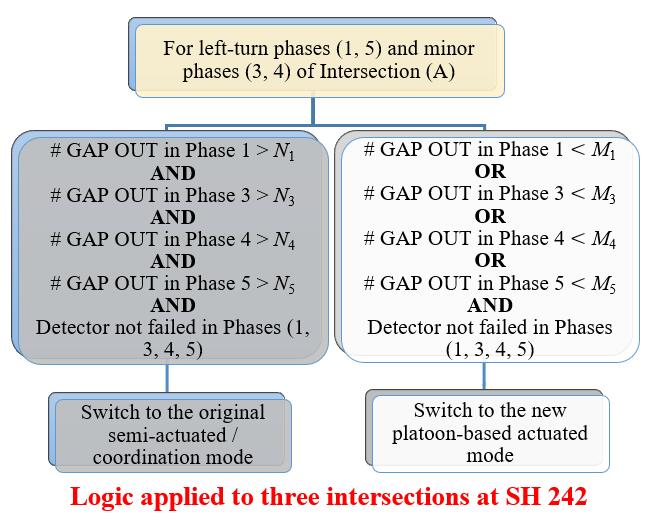
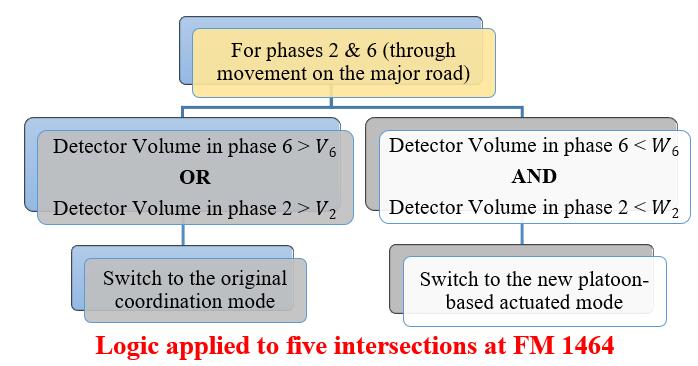
Subtask 3.3 – Phase II: Diamond Interchanges along IH-10
In the third phase, the LU research team implemented the proactive signal control system to 6 isolated diamond interchanges along IH-10 plus two adjacent intersections. All intersections are operated by TTI diamond controllers.
Diamond interchanges are commonly used along the frontage roads of freeways in Texas cities: an arterial road intersects a frontage road twice when passing through a freeway below. The current signal plan applied to the diamond interchanges was developed by the Texas Transportation Institute (TTI).
The signal control system at a diamond interchanges is much more complicated, as a diamond interchange is a combination of two intersections. Overlapping phases exists. The research team develops a completely new control logic, aiming to handle the platoon of vehicles on the arterial roads that cross the frontage road on each side of IH-10.
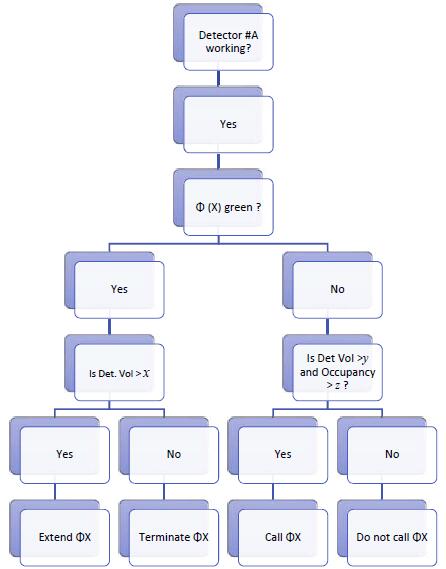 Control Logic Applied to Diamond Interchanges with Loop Detectors
Control Logic Applied to Diamond Interchanges with Loop Detectors
Results
Before and after the implementation at each testbed, the traffic data from detectors were used to evaluate the performance of the implemented systems. Meanwhile, on-site observations were made to record the queue length and delay before and after the implementation.
The following shows the performance of the new system v.s. the old system (semi-control) at two intersections: Gosling Rd. at SH 242 and Bissonnet Rd. at FM 1464.
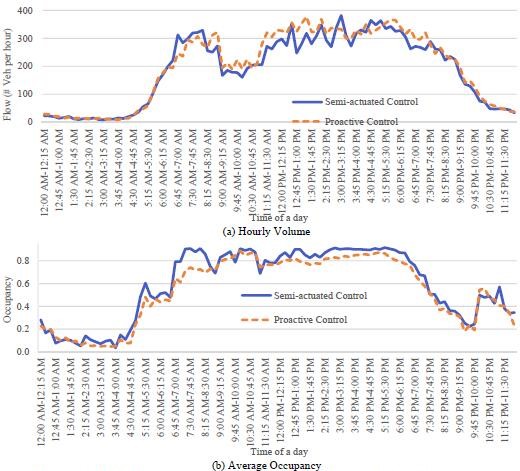
Performance of Weekday Left-turn Traffic from SH 242 to Gosling Rd. under the old (semi-control) and new (proactive control) systems
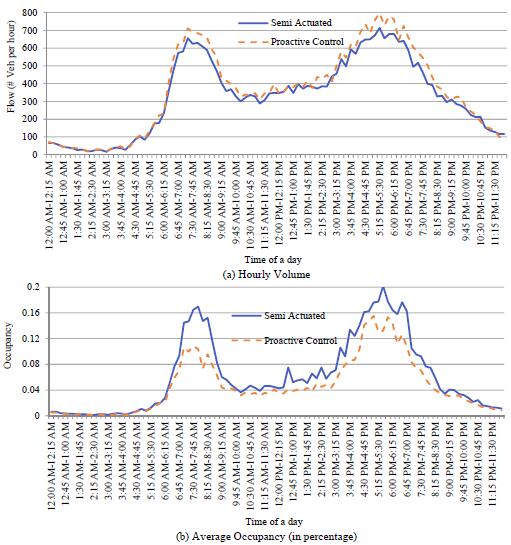
Performance of Weekday Southbound Through Traffic along FM 1464 at Bissonnet Rd. under the old (semi-control) and new (proactive control) systems
Generally speaking, the new control systems were specifically designed for balancing the left-turn and minor traffic and the through traffic on the major road. The data analysis show that the implemented system works well at the intersections at SH 242 and FM 528. For example, in the middle of the weekday (11am – 3pm) when the left-turn traffic to Alden Wood and Gosling Rd. is highest, the implemented system helped increase the flow by 12% and 15% and reduce the occupancy by 13.5% and 6%, respectively.
On the other hand, if the through traffic flow is large (> 600 pc/hr/ln), the new system also works well at the intersections at FM 1464 and diamond interchanges.
After the implementations, the Houston District Office of Texas Department of Transportation has not received any complaint from drivers on these testbeds.
The final report is available.
Funding
Texas Department of Transportation (TxDOT), Project Number 5-6920, $157,794, 4/1/2017 – 12/31/2018.
Loop Detector
